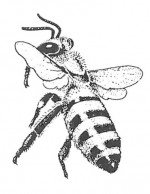
A honey bee family may comprise more than 50,000 individuals. In each family, there is only one egg-laying queen. The workers collect food, nectar and pollen, and inside the nest they build honeycombs, which consist of two layers of hexagonal cells. Some of the cells contain the bees’ larvae. Other cells are used to store honey or pollen. The entire honey bee family overwinter. During the winter, the bees get by with the food they have collected during the summer – or with the sugar, the beekeeper has given them in exchange for the honey. Therefore, they are at full power already in the early spring.
The swarm. After reproducing heavily in late spring, the hive is often too small. This stimulates the workers to raise a number of new queens. The strongest take over as heads of the original family, but before that happens, the original queen leaves the hive with a swarm, about half of the family. The swarm settles down temporarily as a swarming, pear-shaped cluster under a branch or in a bush, and here they stay for a few days until worker bees (which scout in all directions) have found a suitable location for the new hive. Honey bees are not particularly eager to sting while swarming.
When the swarm is out in the open, it is easy for a beekeeper to collect it. When it has settled in a cavity wall, it is almost impossible to get to it.




